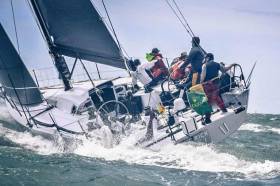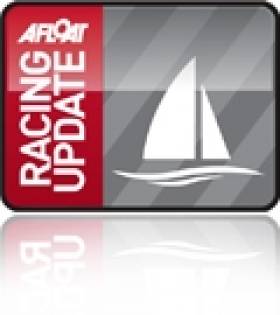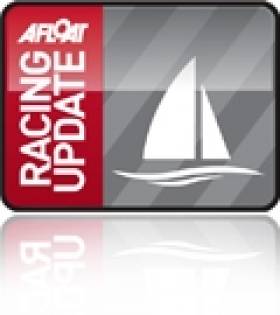Displaying items by tag: Newport to Bermuda Race
Sailor Goes Overboard and Dies in Newport Bermuda Race
The Captain of the yacht Morgan of Marietta has lost his life after going overboard in the 52nd Newport Bermuda Race.
The crew of the yacht Morgan of Marietta, a 42-foot sloop, reported that its captain, Colin Golder of New Providence, N.J., went overboard early this afternoon in strong winds, approximately 325 miles from Bermuda, and did not survive.
After extended effort, Mr Golder’s body was recovered by the vessel’s crew, and the vessel is returning to the mainland. Next of kin has been informed.
In a statement, the Bermuda Race Organising Committee, the Cruising Club of America, and the Royal Bermuda Yacht Club wish to express sincere condolences to the family and crew of Mr Golder.
Further details will be provided as they become available.
Donegal’s Sean McCarter was a member of the crew aboard British yacht Maverick, an Infinity 46R DSS, which won the Open Division of the Newport Bermuda Race.
The race featured a number of Irish crew as Afloat.ie reported previously but it was the former Clipper Race skipper who has Vendee Globe ambitions that earned a race win.
The division winners of the 2018 Newport Bermuda Race were finalized today with the arrival of the remainder of the fleet, after a slow but strategically challenging race. Of the 169 boats that started in Newport on June 15th, 166 completed the 635-mile race in two to six days time (there were three retirements). After making very slow progress in the middle of the racecourse in light to non-existent winds, most of the fleet finished quickly on Tuesday evening and Wednesday morning.
The divisional awards, as well as many other special awards, will be presented on Saturday evening by His Excellency, the Governor of Bermuda, John Rankin. Assisting will be the Commodores of the clubs that co-organise the race, Brad Willauer, of the Cruising Club of America, and Jonathan Corless, of the Royal Bermuda Yacht Club.
The yacht Grundoon, a Columbia 50 skippered by Jim Grundy of Doylestown, Penn., will receive the St. David’s Lighthouse Trophy, the main prize awarded to the first finisher on handicap corrected time among the 85 entries in the St. David’s Lighthouse Division. Grundoon completed the course in 112:12:19. Grundy sailed with his daughter and two sons in the crew; his father purchased Grundoon as a new boat 50 years ago, in 1968, and first entered it in the Newport Bermuda Race in 1972. “This win,” said Grundy, “is for the family!”
Proving that the Newport Bermuda Race is for sailboats and crews of many sizes, speeds and styles, Orca, an Island Packet 38 skippered by Harold Guidotti, of Westbrook, Conn., won the Finisterre Division—a 40-boat fleet for amateur entries using cruising sails—and Wizard, a Volvo Open 70 owned by brothers, Peter Askew of Riderwood, Md.,and David Askew, of Sandy, Utah, won the 22-boat Gibbs Hill Lighthouse Division, for high-performance, professionally crewed boats. Orca completed the course in just over five days, finishing in the early hours of Thursday morning with a time of 123:19:13. Wizard made the trip in 55:37:02, finishing on corrected time ahead of New Yorker George David’s Rambler 88, which was the first boat to cross the finish line, just before sunset on Sunday night, in a time of 50:31:51.
Topping the 15-boat Double-Handed Division was Yankee Girl, a Morris Justine 36 sailed by Zachary Lee and Lief Counter, of Vineyard Haven, Mass., and Pelham, N.Y., respectively. Yankee Girl sailed the racecourse in 116:30:12 and finished first on corrected time by less than eight minutes ahead of Corvus, another Morris 36. This was Lee’s second consecutive Newport Bermuda Race aboard Yankee Girl.
“A high-pressure area slowed most of the fleet significantly,” said Race Chairman Jonathan Brewin, of St. George's, Bermuda, “but it made for a very strategic race. We were delighted to see all the boats arrive in Bermuda safely, maybe not too swiftly, but ultimately all were successful in arriving. Hopefully, everybody had maximum fun. On behalf of the Cruising Club of America and the Royal Bermuda Yacht Club, I’d like to congratulate the fastest in the fleet—from our traditional lighthouse trophy champions to the first winners in the Super Yacht and Multihull Divisions.”
Multihulls were invited to join the race for the first time in 2018, with three boats competing. New Yorker Jason Carroll on Elvis, a Gunboat 62, not only won the division but completed the course as the fifth finisher in a time of 63:25:32.
Two superyachts competed, with the 112-foot Kawil, skippered by Harold “Spook” Stream of Lake Charles, La., winning on corrected time by more than five hours. The satisfaction of crossing the line six minutes ahead of Kawil on elapsed time was had by Daniel Van Starrenburg, of Bedford Hills, N.Y., who sailed his 110-foot Aurelius in an elapsed time of 104:27:32.
First of the two boats in the Open Division was Maverick, an Infiniti 46R DSS skippered by Quentin Stewart of Guernsey, GBR. The light conditions did not favour the radical 46-footer, which is outfitted with lifting foils that provide extra stability and speed when the wind is up, but the sleek British boat nonetheless completed the course 10th fastest, in 97:03:56.
Some results may be subject to change, but any such changes are not expected to affect the winners confirmed in each division.
Sinn Féin & Puma Race to Bermuda
Peter S. Rebovich’s rebelliously-named Cal40 Sinn Fein, is vying to win her third straight St. David’s Lighthouse Trophy this week when she lines out in the Newport - Bermuda RAce. If Sinn Féin wins, she will tie a record set in 1954-60 by Carleton Mitchell’s Finisterre.
A good wind is predicted for the early stages of the 47th Newport Bermuda Race, which starts today off Newport, R.I. The 184-boat international fleet is the third largest in the race’s 104-year history. Nearly 2,000 sailors will compete. The course runs 635 miles from the mouth of Narragansett Bay into the Atlantic Ocean and across the Gulf Stream to the finish line off St. David’s Head, Bermuda. The race should take two to three days for the largest boats, over 80 feet long, and four to six days for the smallest ones of 33 to 40 feet.
“We expect a fine afternoon sea breeze of 10 to 15 knots to get the boats out into the Atlantic,” said Bjorn Johnson, chairman of the Bermuda Race Organizing Committee. “It may get lighter as the boats sail out into the Atlantic, but there will be a strong favorable current in a Gulf Stream meander carrying the boats toward Bermuda.”
The thousands of spectators at the start will include Bermuda’s Governor, Sir Richard Gozney, and Premier, Dr. Ewart Brown. When the first starting gun is fired at 2 p.m. EDT, the two officials will be looking on from a motor yacht with Commodore Sheila McCurdy of the Cruising Club of America and Commodore Peter Shrubb of the Royal Bermuda Yacht Club, the race’s two sponsors.
The 184-boat fleet is divided into five divisions whose final standings will be determined by factoring handicaps into the boat’s elapsed times. The largest with 103 boats is the St. David’s Lighthouse Division for predominately amateur racing crews.
The Cruiser Division is the second largest with 39 boats. Its winner will receive a prize carrying Mitchell’s and Finisterre’s names. Professional racing crews compete in the Gibbs Hill Lighthouse Division (13 boats) for a trophy named for Bermuda’s tallest lighthouse. Three boats with cant keels and other innovations will race in the Open Division for the Royal Mail Trophy.
There also is the 26-entry Double-Handed Division for boats sailed by just two sailors. They sail for the Phillip S. Weld Prize and Moxie Prizes. In addition, the top boat in the IRC rule standings will receive the North Rock Beacon Trophy.
The five divisions are broken down into a total of 16 classes, determined by the boats’ size and type.
The race for first to finish will very likely be between the largest boats in the fleet, the 99-foot Speedboat in the Open Division and the 90-foot Rambler in the Gibbs Hill Division.
In a statement to the sailors, Commodores McCurdy and Shrubb said, “Hundreds of sailors and thousands of supporters make this race a major international sporting event every two years. Ocean racing is a marathon of endurance and finesse. Some experienced crews may make this year’s race look easy: Others will learn more than they thought they would. The challenges can be both stressful and satisfying.”
They added, “The fleet is first class, and the hospitality and facilities of the New York YC in Newport, and in Bermuda are unsurpassed. The members of our two clubs have volunteered countless hours of planning and preparation. Now we are all ready to let the fun begin!”
Shinners go for Third Newport/Bermuda Win
The Cal 40 crew of Sinn Féin are looking for their third consecutive Newport-Bermuda scalp this year, with a hat-trick a very real prospect. In 46 races since 1906, just three boats have won the major prize, the St. David’s Lighthouse Trophy, at least two times. A pair of these boats won consecutive races – Carleton Mitchell’s fabled Finisterre in 1956-60 and, in the two most recent races in 2006 and 2008, Peter S. Rebovich’s Sinn Fein, from New Jersey’s Raritan Yacht Club. Rebovich and his usual crew will be back again this year with the gleam of a third St. David’s Lighthouse Trophy in their eyes.
How does this 45-year old stock Cal 40 sloop do so well, so often against much newer and more sophisticated custom boats? The explanation is that this is a happy marriage of a good boat to an able amateur crew that has been racing her for decades. During Finisterre’s glory days half a century ago, one of her regular crew credited Mitchell’s “good admiralship” – meaning his cheerful but firm, detail-driven, open-minded command of a deeply loyal crew. The same can be said of Pete Rebovich and his guys.
One thing that cannot be said about them is that they’re riding a brief lucky streak. When Sinn Fein first raced offshore in the Marion to Bermuda Cruising Yacht Race in the 1980s, she won class and family prizes. She’s sailed six Newport Bermuda Races, paying her dues with low finishes before winning her class in 2002 and 2004 and then taking the St. David’s Lighthouse Trophy, first in a drifter in a glassy sea in 2006 followed by a classic upwind thrash to the Onion Patch in 2008. Over Memorial Day weekend, she won her class in the 2010 Block Island Race, the major tune-up for the Bermuda Race.
Sinn Fein has also won the Olin J. Stephens Ocean Racing Trophy three straight times – in fact, the only times it has been presented – for the best combined performance in successive Newport Bermuda Races and Marblehead to Halifax Ocean Races. Rebovich has a special memory of winning the first Stephens Trophy because the presentation of the award to the 70-year-old winning skipper was made by 99-year-old Olin Stephens himself. “We won, and while I was hobbling to the stage to meet him and receive the trophy, he commented, ‘Isn't it nice to see an old guy, like me, still out there racing – and winning.’”
Full article on the official race website, HERE.


























































